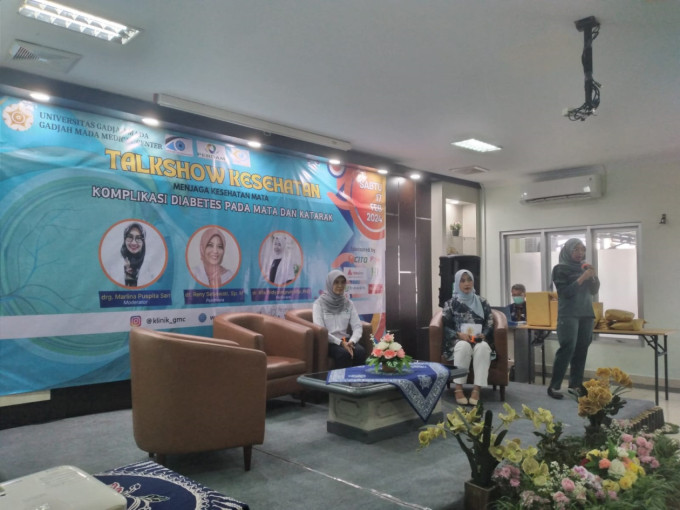
Gadjah Mada Medical Center (GMC) orchestrated an enlightening talk show coupled with complimentary eye examinations for the local community to champion public health awareness. This event sought to disseminate insights about diabetes complications and cataracts.
Taking center stage at the GMC Meeting Hall, the talk show titled “Diabetes Complications in the Eyes and Cataracts,” held on Saturday (Feb. 17), featured two esteemed ophthalmology and cataract specialists as keynote speakers.
“Vision impairment inevitably hampers productivity. Any task becomes arduous when our eyesight is compromised, underscoring early screening and detection necessity,” said Dr. Yayuk Soraya, the Head of GMC.
“We orchestrated this event with Gadjah Mada Medical Center’s anniversary. We aspire for this initiative to be a beacon of support in fostering optimal eye health for everyone.”
The Indonesian Ministry of Health has underscored cataracts as a predominant health concern in Indonesia. Statistics from 2017 reveal that a staggering 8 million individuals aged 50 and above grapple with vision impairments, with 81.2% attributed to cataracts.
Various factors contribute to cataract development, including advanced age, congenital conditions in children, and diabetes-related complications.
“When discussing cataracts, the analogy often drawn is that of a camera lens. Given that roughly 80% of information is visually acquired, our eyes serve as the lens, and when cataracts manifest, this lens becomes cloudy, obstructing vision. It’s crucial to note that cataracts develop internally, not externally, impacting both near and far vision,” elucidated Reny Setyowati, MD.
Despite ranking among the top five causes of blindness, cataracts are treatable, underscoring the significance of prompt symptom recognition for streamlined management.
Setyowati highlighted blurry vision as one of the initial indicators of cataracts. This condition typically starts as a small, blurred patch, progressively enlarging and enveloping the eye lens. It may also manifest as a film covering the lens, gradually advancing inward.
Individuals experiencing such symptoms are urged to seek medical evaluation promptly. The government has rolled out numerous initiatives to bolster Indonesia’s Cataract-Free campaign, offering the public free cataract screenings and surgeries.
“Cataracts can affect individuals of all ages, from newborns to the elderly. In infants, infections during pregnancy are often the catalyst. In older adults, prolonged exposure to ultraviolet rays and diabetes are predominant triggers. With diabetes, elevated blood sugar levels accumulate in the eye lens, expediting cataract formation,” elaborated Setyowati.
In contrast to conventional cataracts, those induced by diabetes or diabetic retinopathy pose greater treatment challenges and elevate the risk of blindness. Dr. Rifa Widyaningrum underscored that diabetic retinopathy entails cataract development affecting the retina or the eye’s nerve membrane.
These symptoms stem from hyperglycemia, where uncontrolled diabetes mellitus (DM) precipitates adverse ocular effects. Persistent hyperglycemia can culminate in irreversible blindness.
“Prolonged hyperglycemia precipitates vascular anomalies in the eyes, characterized by the proliferation of minuscule blood vessels, hemorrhaging, and retinal discoloration,” said Dr. Widyaningrum.
This variant of cataracts predominantly affects diabetic individuals grappling with pregnancy or persistent hyperglycemia. Fulfilling awareness of healthy lifestyle practices, including regular exercise and dietary management, is imperative to mitigate risks.
The talk show and complimentary eye screenings, commemorating GMC’s 23rd-anniversary dedication, epitomize UGM’s commitment to community welfare.
This endeavor aligns with Sustainable Development Goal (SDG) 3, underscoring the imperative of fostering good health and well-being. The overarching objective is to foster heightened public consciousness regarding the pivotal role of health maintenance, particularly in averting cataracts and diabetes.
Author: Tasya

